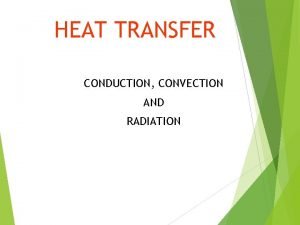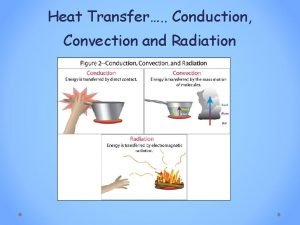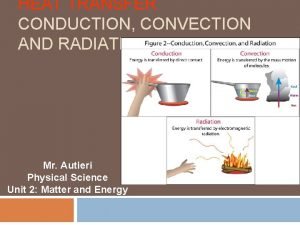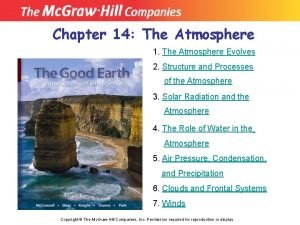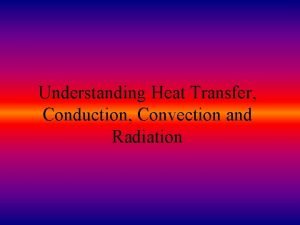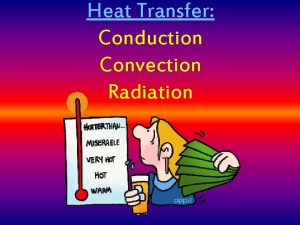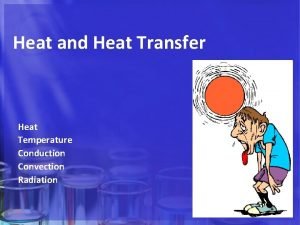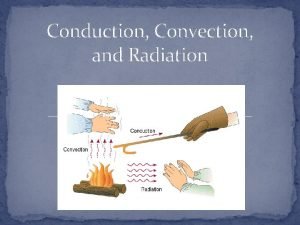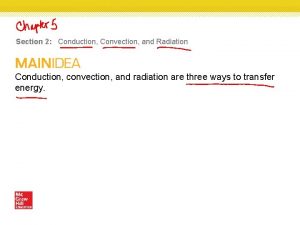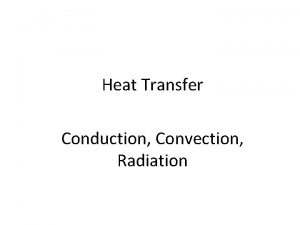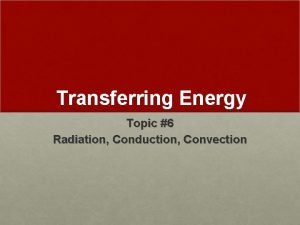ENERGY TRANSFER IN THE ATMOSPHERE Radiation Conduction Convection










- Slides: 10

ENERGY TRANSFER IN THE ATMOSPHERE Radiation, Conduction, Convection; Angle of Insolation; Heat at the Surface vs. Heat in the Atmosphere

THERMODYNAMICS & ENERGY TRANSFER • Thermodynamics - the science concerned with the relations between heat and mechanical energy or work, and the conversion of one into the other: modern thermodynamics deals with the properties of systems for the description of which temperature is a necessary coordinate. • There are 3 major Laws of Thermodynamics: • The first law, also known as the Law of Conservation of Energy, states that energy can not be created or destroyed; it can only be redistributed or changed from one form to another. • The second law of thermodynamics says that the ENTROPY of any isolated system not in thermal equilibrium almost always increases. • The third law of thermodynamics states that the entropy of a system approaches a constant value as the temperature approaches zero.

4 TYPES OF ENERGY TRANSFER Radiation Conduction movement of energy movement of through space by energy through electromagnetic direct contact waves Convection fluid movement of energy caused by temperature differences Latent Heat heat absorbed or released in a phase change

CONVECTION. . . WARM AIR RISES, COOL AIR SINKS!!! - Is the major mechanism of energy transfer in the oceans, atmosphere and Earth’s interior - Convection in the atmosphere is a major cause of weather

ENERGY TRANSFER BETWEEN EARTH’S SURFACE AND THE ATMOSPHERE CREATES THE WEATHER (Answer to the question…)

ANGLE OF SUNLIGHT (AKA ANGLE OF INSOLATION) Earth’s surface is much more efficiently heated by the sun than is the atmosphere. The amount of energy reaching any given point on Earth’s surface is controlled by the angle of sunlight striking the surface and varies with seasons.

INCOMING SOLAR RADIATION 100% of the incoming energy from the sun is balanced by 100% percent total energy outgoing from the earth. From: http: //forecast. weather. gov/jetstream/atm os/energy_balance. htm

ENERGY TRANSFER IN THE ATMOSPHERE Copy as “incoming” Copy as “outgoing” Amount that is used in our atmosphere = ____%?

WAVES OF ENERGY • Wavelengths of energy with electric and magnetic properties are known as electromagnetic radiation. • Visible light is one type of ER; another is Ultraviolet (UV) Radiation.

THE GREENHOUSE EFFECT AND THE OZONE Earth has a “natural” greenhouse effect; this is good, as long as the energy budget is kept in balance. The ozone layer helps to absorb harmful UV radiation, helping to protect us while keeping the global temperatures in balance. Excess gases from human activity get trapped by the ozone in our atmosphere and the energy is out of balance.
 What is heat transfer conduction convection and radiation
What is heat transfer conduction convection and radiation Example of heat transfer by radiation
Example of heat transfer by radiation Does radiation travels in straight lines
Does radiation travels in straight lines Radiation example
Radiation example Heat energy transfer
Heat energy transfer Venn diagram about solid liquid and gas
Venn diagram about solid liquid and gas Venn diagram of conduction, convection and radiation
Venn diagram of conduction, convection and radiation Radiation heat transfer
Radiation heat transfer Types of heat transfers
Types of heat transfers Temperature, conduction, convection, radiation.
Temperature, conduction, convection, radiation. Whats conduction convection and radiation
Whats conduction convection and radiation

